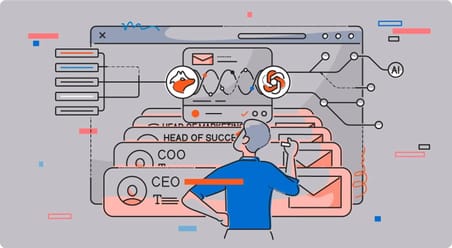6 Outreach Mistakes Killing Your Reply Rates (And How to Fix Them)

If your reply rates have flatlined, you’re not alone.
Outreach in 2026 requires clarity, personalization, and strong data hygiene — three things many small teams overlook.
According to Hunter research, only 4.1% of cold emails get a reply — not because cold email is dead, but because it’s being done wrong.
Here are the six most common mistakes hurting your performance (and how to fix them).
TL;DR
Here’s what you need to know:
- Verify before sending. Bad data kills deliverability.
- Track what matters. Replies and deliverability > opens.
- Follow up. 3–5 touchpoints double your chance of replies.
- Use AI wisely. It’s an assistant, not an autopilot.
- Smaller lists win. <50 contacts = 3× higher reply rates.
- Mix up your goals. Don’t only pitch — offer value too.
1. You’re automating before verifying
Automation is powerful, but it’s only as good as your data.
Sending to unverified or outdated addresses crushes deliverability — which means your emails never reach inboxes.
Fix it: Use Hunter's email checker and enrichment tools to ensure your lists are accurate before sending.
With a Hunter Starter plan, your data is automatically re-verified every month, free of charge — so your lists stay clean and credible.
2. You’re skipping the second touch
It’s not your first email that gets the reply — it’s often your second or third.
Our Multichannel Survey found that 49% of B2B professionals report higher reply rates when using 3–5 touchpoints, compared to just one or two.
The lesson here is that repetition matters. But, you need to add value with a different message and reason for someone to reply (and no, that doesn’t mean changing one or two words.)
Fix it: Build multi-step sequences and schedule thoughtful follow-ups that add value.
A LinkedIn nudge or quick check-in with a new resource can double your chances.
3. You’re using AI as a shortcut, not a tool
AI tools can speed up drafting, but they can’t replace human context.
In Hunter Lab’s research, 67% of decision-makers said they don’t mind AI-written emails — as long as they feel relevant.
Fix it: Use AI to brainstorm hooks or write first drafts of emails, then personalize with real data — company, role, or region.
Let AI make you faster, not lazier.
4. You’re chasing volume, not connection
In 2022, volume was everything. But in 2025, smaller, smarter lists win.
Campaigns with 50 or fewer recipients perform nearly 3× better than mass blasts.
Fix it: Focus on segmentation and relevance.
Build niche lists using Hunter’s filtering tools in Leads or Discover to target specific personas.
You’ll spend less time guessing and more time connecting.
5. You’re only running one type of campaign
If every email you send asks for a meeting, your outreach will hit a wall.
Founders and marketers who mix campaign types — such as sharing insights, inviting peers to roundtables, or asking for feedback — see stronger long-term engagement.
Outreach isn’t just about “book a call.” It’s about starting conversations.
Here are some examples to consider:
- Use Discover to uncover your market and then find potential investors to email
- Run outbound to set up roundtable discussions with potential leads
- Turn a lead’s post on LinkedIn into a discussion point over email
For small teams, this mix keeps your name top-of-mind without sounding pushy.
Fix it: Use Hunter’s AI Writing Assistant to quickly create variations of campaigns — from investor intros to industry insight shares — and run them in parallel.
You’ll stay consistent while keeping your messaging fresh and credible.
6. You’re not measuring what matters
Open rates don’t tell you who’s engaged — just who loaded an image.
Tracking pixels can even hurt deliverability.
The real metrics? Replies and domain health.
Fix it: Track verified replies and deliverability inside Hunter Campaigns.
You’ll know exactly what’s working — and what’s not.
Don’t lose leads to bad data
Small businesses don’t need big budgets to make big moves.
Clean, verify, and enrich your lists with a Hunter Starter plan, and turn your next campaign into real conversations — not wasted sends.



![How Small Teams Running Multichannel Lead Generation in 2026 [Infographic]](/blog/content/images/size/w452/2025/10/Multichannel-infographic-header.png)
 Send cold emails with Hunter
Send cold emails with Hunter